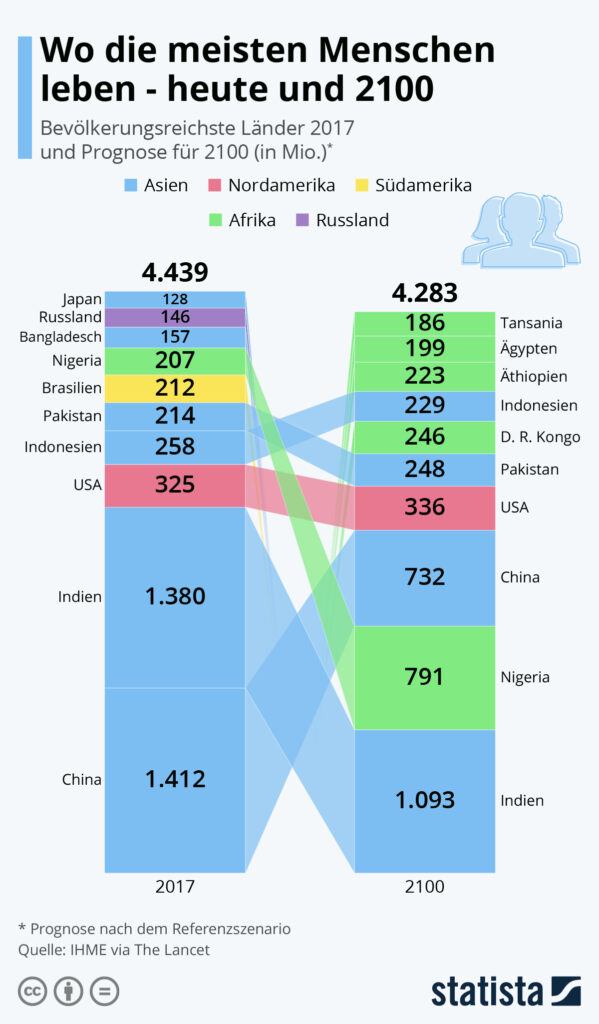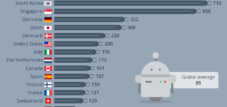Wo die meisten Menschen leben: Heute und 2100 – Where most people live: Today and 2100
Sprachauswahl 📢
Veröffentlicht am: 6. September 2020 / Update vom: 6. September 2020 – Verfasser: Konrad Wolfenstein
Einer aktuellen Prognose wird sich die Reihenfolge der Liste der 10 bevölkerungsreichsten Länder der Welt bis ins Jahr 2100 deutlich verändern. Das zeigt die Statista-Grafik auf Basis von Daten des Institutes for Health Metrics and Evaluation (IHME). Danach wird China in diesem Zeitraum die Hälfte seiner Einwohnerzahl einbüßen und in der Liste werden fünf afrikanische Länder sein. Derzeit ist lediglich Nigeria in der Top-Liste. Die Subsahara-Region in Afrika die einzige Region der Welt, die bis zum Ende des Jahrhunderts weiter wachsen wird. Der Bevölkerungsrückgang in den stark schrumpfenden Staaten hat laut Forschung verschiedene Gründe. Demnach gibt es einerseits Staaten mit hoher Abwanderung, wie etwa die südosteuropäischen Staaten, in Richtung der finanzkräftigeren und lohnstärkeren EU-Länder Zentral- und Westeuropas. Vor allem im Bereich der Pflege und bei Handwerksberufen verlassen viele Arbeitende ihr Heimatland. In anderen Ländern schrumpft die Geburtenrate deutlich, so etwa in China. Forscher des IHME gehen – im Gegensatz zur UN Population Devision – davon aus, dass die Zahl der Weltbevölkerung im Jahr 2100 geringer sein wird als 2017. Die UN-Prognose bei einem mittlereren angenommenen Bevölkerungswachstum rechnet im Jahr 2100 mit einer Weltbevölkerung von insgesamt 10,9 Milliarden Menschen (Excel-Download, Datenblatt “Medium Variant”). Forscher des IHME rechnen im Basiszenario mit 8,8 Milliarden Menschen.
Das IHME ist ein Forschungsinstitut, das im Bereich der globalen Gesundheits- und Demografieentwicklung an der University of Washington in Seattle tätig ist. Für Ihre Prognose haben die Forscher eine Reihe demografischer Faktoren berücksichtigt, etwa die steigende Lebenserwartung, Migrations- und Fertilitätsraten oder den Zugang zu Verhütungsmitteln.
According to a current forecast, the order of the list of the 10 most populous countries in the world will change significantly by the year 2100. This is shown in the Statista graph based on data from the Institute for Health Metrics and Evaluation (IHME). According to the graph, China will lose half of its population during this period and there will be five African countries on the list. Currently, only Nigeria is in the top list. Sub-Saharan Africa is the only region in the world that will continue to grow by the end of the century. According to research, there are various reasons for the population decline in these rapidly shrinking states. On the one hand, there are states with high emigration, such as the Southeast European states, towards the financially stronger and more wage-intensive EU countries of Central and Western Europe. Many workers leave their home countries, especially in the care and craft trades sectors. In other countries, the birth rate is shrinking significantly, for example in China. In contrast to the UN Population Division, researchers at IHME assume that the world population will be smaller in 2100 than in 2017. The UN forecast, assuming a medium assumed population growth rate, predicts a total world population of 10.9 billion people in 2100 (Excel download, data sheet “Medium Variant”). Researchers at IHME expect 8.8 billion people in the base scenario.
IHME is a research institute working in the field of global health and demographic development at the University of Washington in Seattle. For their forecast, the researchers have taken a number of demographic factors into account, such as rising life expectancy, migration and fertility rates, and access to contraception.























